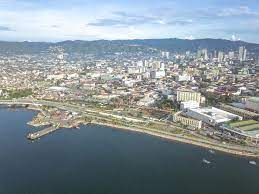Cebu City
Cebu City, officially the City of Cebu (Cebuano: Dakbayan sa Sugbo; Filipino: Lungsod ng Cebu), is a 1st class highly urbanized city in the Central Visayas region of the Philippines. It is the capital of the Cebu Province, where it is geographically located but is one of three cities (together with Lapu-Lapu City and Mandaue City) that are administratively independent of the provincial government. According to the 2020 census, it has a population of 964,169 people, [8] making it the sixth-most populated city in the nation and the most populous in the Visayas.
It also serves as the regional center of Central Visayas and its metropolitan area exerts influence on commerce, trade, industry, education, culture, tourism, and healthcare beyond the region, over the entire Visayas and partly over Mindanao. It is the Philippines’ main domestic shipping port and is home to about 80% of the country’s domestic shipping companies.
Cebu City is bounded on the north by the town of Balamban and the city of Danao, on the west by the city of Toledo, on the east by the cities of Lapu-Lapu and Mandaue and the towns of Liloan, Consolacion and Compostela and to the south by the city of Talisay. Located at the center of the eastern seaboard of Cebu Island, it is the core city of Metro Cebu, the second largest metropolitan area in the Philippines, which includes the cities of Carcar, Danao, Lapu-Lapu, Mandaue, Naga and Talisay and the municipalities (towns) of Compostela, Consolacion, Cordova, Liloan, Minglanilla and San Fernando. Metro Cebu had a total population of 3,165,799 as of the 2020 census, making it the third-most populous metropolitan area of the nation, after Metro Manila in Luzon and Metro Davao in Mindanao.[9]
The current political boundaries of the city are an incorporation of the former municipalities of Cebu, San Nicolas, El Pardo, Mabolo, Talamban and Banilad in the Commonwealth period.[10]
In the Precolonial period, the area of what is today Cebu was occupied by the Rajahnate of Cebu which was known to the Ming dynasty as the nation of Sokbu (束務).[11] The capital of which was Singhapala (சிங்கப்பூர்) which is Tamil-Sanskrit for “Lion City”, the same rootwords with the modern city-state of Singapore.
The city has experienced rapid economic growth since the 1990s, a phenomenon also known as “Ceboom”. Owing to its economic importance and influence in modern times, Cebu City is also popularly referred to as the Queen City of the South.
Etymology
The name “Cebu” came from the old Cebuano word sibu or sibo (“trade”), a shortened form of sinibuayng hingpit (“the place for trading”). It was originally applied to the harbors of the town of Sugbu, the ancient name for Cebu City. Sugbu or Sugbo, in turn, was derived from the Old Cebuano term for “scorched earth” or “great fire”.[12][13]
History
This section needs additional citations for verification. Please help improve this article by adding citations to reliable sources. Unsourced material may be challenged and removed.
Find sources: “Cebu City” – news · newspapers · books · scholar · JSTOR (April 2019) (Learn how and when to remove this template message)
See also: Lapulapu and Rajahnate of Cebu
Founding
Main article: Singhapala
Before the arrival of the Spaniards, Cebu City was part of the island-rajahnate and trade center of Pulua Kang Dayang or Kangdaya (literally “[the islands] which belong to Baya”), now better known as the Rajahnate of Cebu. It was founded by a prince of the Hindu Chola dynasty of Sumatra, the half-Malay and half-Tamil, Sri Lumay. The name Sugbo (shortened form of Kang Sri Lumaying Sugbo, literally “that of Sri Lumay’s great fire”) refers to Sri Lumay’s scorched earth tactics against Muslim Pirates or Moro raiders (Magalos).[12][13] The capital of the Cebu Rajahnate was called Singhapala on what is now modern day northern Cebu City.
Spanish period
19th century kiosk containing the Magellan’s Cross, which is said to be the cross planted by Ferdinand Magellan’s expedition in 1521.
On April 7, 1521, Portuguese explorer at the service of the Spanish Crown and leader of the first expedition to circumnavigate the world, Ferdinand Magellan, landed in Cebu. He was welcomed by Rajah Humabon (also known as Sri Humabon or Rajah Humabara), the grandson of Sri Lumay, together with his wife and about 700 native islanders. Magellan, however, was killed in the Battle of Mactan, and the remaining members of his expedition left Cebu soon after several of them were poisoned by Humabon, who was fearful of foreign occupation. The last ruler of Sugbo, prior to Spanish colonization, was Rajah Humabon’s nephew, Rajah Tupas (d. 1565).[12][13]
On February 13, 1565, Spanish and Novohispanic (Mexican) conquistadors led by Miguel López de Legazpi together with Augustinian friars whose prior was Andrés de Urdaneta, left New Spain (modern Mexico) and arrived in Samar, taking possession of the island thereafter. They Christianized some natives and Spanish remnants in Cebu. Afterwards, the expedition visited Leyte, Cabalian, Mazaua, Camiguin and Bohol where the famous Sandugo or blood compact was performed between López de Legazpi and Datu Sikatuna, the chieftain of Bohol on March 16, 1565. The Spanish arrived in Cebu on April 15, 1565. They then attempted to parley with the local ruler, Rajah Tupas, but found that he and the local population had abandoned the town. Rajah Tupas presented himself at their camp on May 8, feast of the Apparition of Saint Michael the Archangel, when the island was taken possession of on behalf of the Spanish King. The Treaty of Cebu was formalized on July 3, 1565. López de Legazpi’s party named the new city “Villa de San Miguel de Cebú” (later renamed “Ciudad del Santísimo Nombre de Jesús).” In 1567 the Cebu garrison was reinforced with the arrival of 2,100 soldiers from New Spain (Mexico).[a] The growing colony was then fortified by Fort San Pedro.
A 19th-century map of Cebu City
By 1569, the Spanish settlement in Cebu had become important as a safe port for ships from Mexico and as a jumping-off point for further exploration of the archipelago. Small expeditions led by Juan de Salcedo went to Mindoro and Luzon, where he and Martín de Goiti played a leading role in the subjugation of the Kingdoms of Tundun and Seludong in 1570. One year later, López de Legazpi departed Cebu to discuss a peace pact with the defeated Rajahs. An agreement between the conquistadors and the Rajahs to form a city council paved the way for the establishment of a new settlement and the construction of the Christian walled city of Intramuros on the razed remains of Islamic Manila, then a vassal-state of the Sultanate of Brunei.
In 1571, the Spanish carried over infantry from Mexico, to raise an army of Christian Visayan warriors from Cebu and Iloilo as well as mercenaries from the Tagalog region, and assaulted the Sultanate of Brunei in what is known as the Castilian War. The war also started the Spanish–Moro Wars waged between the Christian Visayans and Muslim Mindanao, wherein Moros burned towns and conducted slave raids in the Visayas islands and selling the slaves to the Sultanates of the Malay Archipelago and the Visayans fought back by establishing Christian fort-cities in Mindanao, cities such as Zamboanga City.
On August 14, 1595, Pope Clement VIII created the diocese of Cebu as a suffragan to the Archdiocese of Manila.
On April 3, 1898, local revolutionaries led by the Negrense Leon Kilat rose up against the Spanish colonial authorities and took control of the urban center after three days of fighting. The uprising was only ended by the treacherous murder of Leon Kilat and the arrival of soldiers from Iloilo and Manila.[15][16] On December 26, 1898, the Spanish Governor, General Montero, evacuated his troops to Zamboanga, turning over government property to Pablo Mejia.[17] The next day, a provincial government was formed under Luis Flores as president, General Juan Climaco as military chief of staff, and Julio Llorente as mayor.

